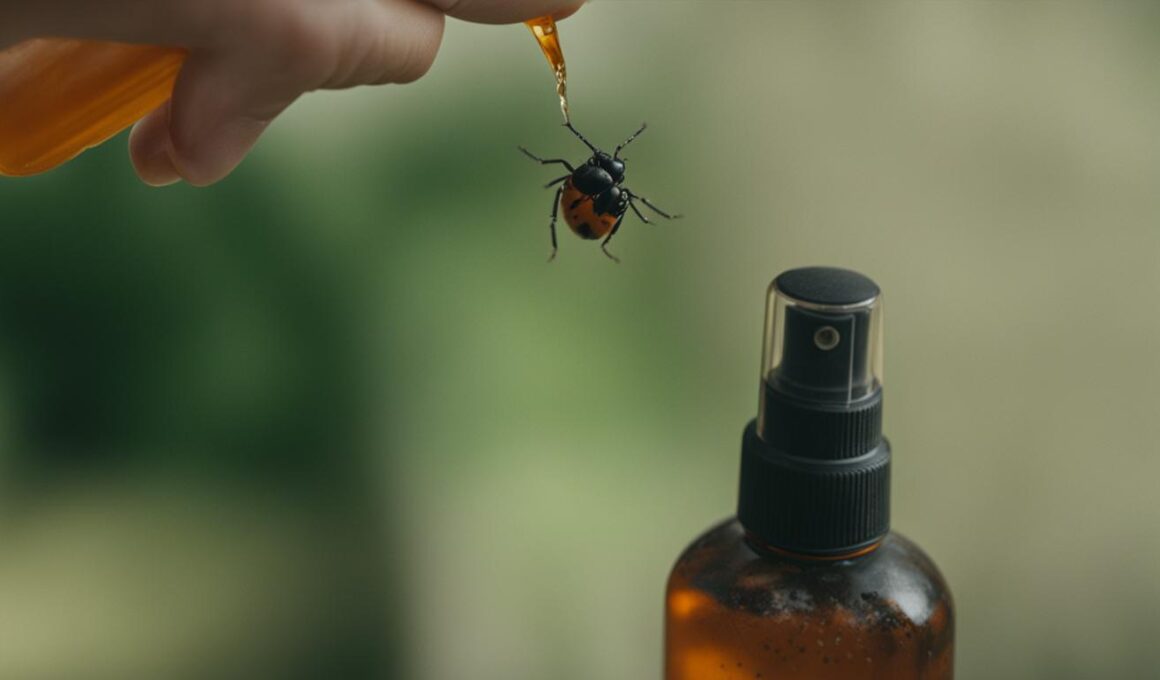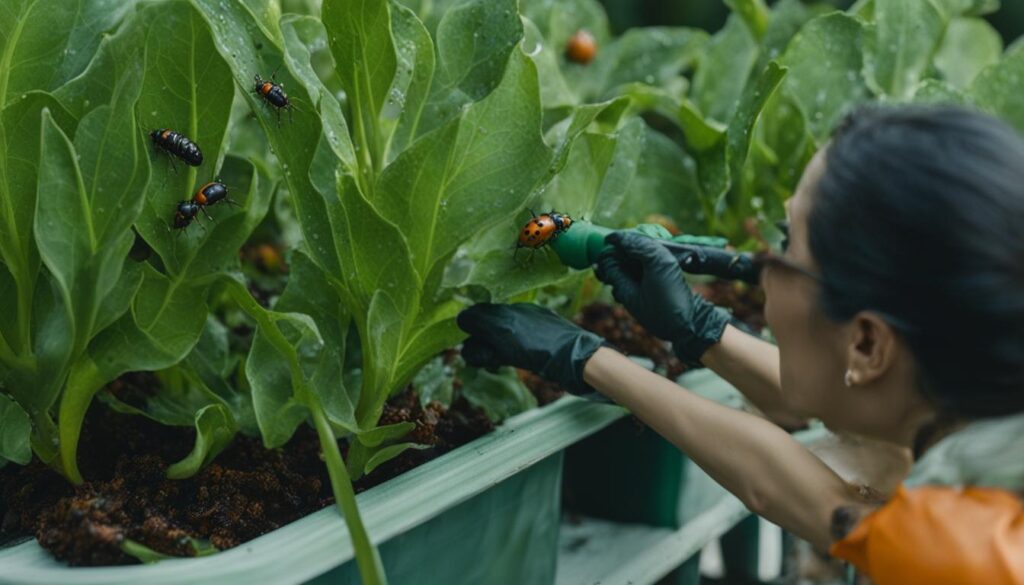Jadera bugs, also known as golden rain tree bugs or red-shoulder bugs, can be a nuisance when they invade your yard or home. They are attracted to plants like ficus, goldentree seeds, and other fruits or seeds. To get rid of jadera bugs, you can use Prothor spray in your yard to control their population. Apply the spray using a hose end sprayer, focusing on the turf, trees, and siding. Inside your home, use FS MP Aerosol to treat entry points like windows, doors, and vents. These tips will help you eliminate jadera bugs and keep your home bug-free.
Post Summary
- Identify jadera bugs by their black or brownish-black bodies with red eyes and red shoulder stripes.
- Remove food sources like golden rain tree seedpods and fallen fruit from your yard to discourage jadera bugs.
- Use water to disperse jadera bugs by spraying them off plants and surfaces or shaking them into soapy water.
- Consider using soapy water or environmentally-friendly pesticides to control jadera bug populations.
- Regularly monitor your yard for signs of jadera bugs and other spring pests to take proactive measures.
Identifying Jadera Bugs and Their Behavior
Jadera bugs, also known as golden rain tree bugs or red-shoulder bugs, can be easily identified by their distinctive features. They have black or brownish-black bodies with red eyes and red shoulder stripes. The nymphs are bright red in color. These bugs are primarily attracted to plants like golden rain trees, Rose-of-Sharon, Chinaberry, and ash. They feed on the seeds of these plants and tend to congregate in mulch or leaf litter. While they can be beneficial as they reduce the number of volunteer seedlings, their populations can become a nuisance if left unchecked.
To effectively manage jadera bug infestations, it is important to understand their behavior. These bugs are most active during the warmer months, with peak activity in spring and summer. They are attracted to areas with abundant food sources, such as trees and plants that produce seeds. Jadera bugs prefer warm and sunny locations, often shading themselves during the hottest parts of the day. They are known to congregate in large numbers, making their presence more noticeable.
To determine if you have a jadera bug infestation, look for the following signs:
- The presence of jadera bugs on plants, especially golden rain trees, Rose-of-Sharon, Chinaberry, or ash.
- Clusters of bugs in mulch or leaf litter.
- Seed pods or damaged seeds around the affected plants.
- Red staining on surfaces caused by their excrement.
By identifying jadera bugs and understanding their behavior, you can take appropriate measures to control their populations and minimize the impact on your yard or home.
Identifying Jadera Bugs
| Feature | Description |
|---|---|
| Body Color | Black or brownish-black |
| Eye Color | Red |
| Shoulder Stripes | Red |
| Nymph Color | Bright red |
Removing Food Sources and Changing Ground Cover
To effectively get rid of jadera bugs, it is important to start by removing their food sources. If you have golden rain trees or chinaberry trees in your yard, make sure to regularly rake up the seedpods and remove them. These bugs are primarily attracted to the seeds of these plants, so by eliminating the food source, you can discourage them from congregating in your yard and reduce their populations.
If you find it difficult to remove the seeds from your yard, consider changing your ground cover to something like mulch. This can make it easier to remove the seeds and prevent them from accumulating, further deterring jadera bugs. Additionally, regularly remove any fallen fruit or seed from your yard to eliminate potential food sources for these pests.
By removing food sources and changing your ground cover, you can create an environment that is less appealing to jadera bugs. This, in turn, can help reduce their populations and make it easier to keep your yard bug-free.
| Food Sources for Jadera Bugs | Recommended Actions |
|---|---|
| Golden rain trees | Rake up and remove seedpods regularly |
| Chinaberry trees | Rake up and remove seedpods regularly |
| Fallen fruit or seed | Regularly remove from your yard |
By following these actions, you can greatly reduce the presence of jadera bugs in your yard and create a less hospitable environment for them.
Using Water to Disperse Jadera Bugs
Jadera bugs can be quite resilient and difficult to eliminate, but one effective method to disperse them is by using water. By spraying jadera bugs with water, you can physically remove them from plants and surfaces, reducing their populations and preventing further infestation. This method is especially useful when jadera bugs have congregated on walls or other hard surfaces.
You can use a hose or pressure cleaner to spray the bugs off plants and surfaces. The force of the water can easily dislodge them, making it easier to control their presence in your yard. Simply direct the water stream towards the bugs, ensuring you cover all the affected areas. This can be a quick and efficient way to get rid of large clusters of jadera bugs.
For a more targeted approach, you can also shake the plants to knock the bugs into a bucket of soapy water or rubbing alcohol. This method works best when the jadera bugs are young and congregated in groups. By shaking the plants, you can dislodge the bugs and collect them in the solution, effectively killing them.
“Using water to disperse jadera bugs is an environmentally-friendly method that can be helpful in managing their populations. The force of the water can easily remove the bugs from plants and surfaces, providing immediate relief from their presence.”
Remember, it’s important to take proactive measures to control jadera bugs and prevent infestations. Regularly monitoring your yard and using methods like spraying jadera bugs with water can help keep their populations in check. By incorporating these practices into your pest control routine, you can effectively manage jadera bugs and maintain a bug-free environment.
Using Soapy Water and Pesticides for Jadera Bug Control
When dealing with a jadera bug infestation, you have several options for effective control. One method that is environmentally-friendly and non-toxic is the use of soapy water. By mixing dish soap with water and directly spraying it on the bugs, you can effectively kill them. The soap acts as a poison to the bugs and reduces the surface tension, making it difficult for them to grip onto surfaces. This method is safe for use both indoors and outdoors, making it an ideal choice for controlling jadera bugs.
Another option for controlling jadera bugs is the use of pesticides. Horticultural oils or insecticidal soaps can be used to treat jadera bug populations. These products are specifically formulated to target and eliminate these pests. If the infestation is severe, chemical pesticides such as Prothor or those containing pyrethroid can be used. It is important to carefully read and follow the instructions on the pesticide label to ensure safe and effective use.
Table:
| Pesticide | Description | Application |
|---|---|---|
| Horticultural Oils | Natural oils that suffocate and kill jadera bugs | Spray directly on affected areas |
| Insecticidal Soaps | Potent soaps that kill jadera bugs on contact | Spray directly on bugs or affected areas |
| Prothor | Chemical pesticide effective against jadera bugs | Follow label instructions for application |
| Pyrethroid-based Pesticides | Chemical pesticides that target jadera bugs | Follow label instructions for application |
When using pesticides, it is important to exercise caution and follow all safety guidelines. Keep in mind that pesticides can be harmful to other beneficial insects and the environment, so it is advisable to use them as a last resort and only if necessary.
Managing Other Spring Pests
While dealing with jadera bugs, it is important to also manage other spring pests that can wreak havoc on your plants and gardens. Two common pests to watch out for are aphids and scale insects. By taking proactive measures to control these pests, you can ensure the health and vitality of your plants.
Aphid Control
Aphids are tiny insects that often infest new growth on plants, causing leaves to curl and become distorted. To control aphids, you can use horticultural oils or insecticidal soaps. These products suffocate the pests and prevent them from feeding on your plants. It is important to thoroughly coat the affected areas, paying close attention to the undersides of leaves where aphids often hide. Regular inspections and immediate action can prevent aphid populations from spiraling out of control.
Scale Insect Control
Scale insects, both hard and soft scales, are another common pest in the spring. These pests latch onto plants and feed on their sap, causing wilting, yellowing, and stunted growth. To control scale insects, inspect your plants every few days for the crawler stage, which is the most vulnerable phase. Use horticultural oil sprays to treat affected areas, ensuring thorough coverage. If infestations are severe, consider pruning heavily infested plants, such as coontie sago palms, to remove the scale insects and promote plant health.
| Pest | Control Method |
|---|---|
| Aphids | Use horticultural oils or insecticidal soaps. Thoroughly coat affected areas, especially the undersides of leaves. |
| Scale Insects | Inspect plants regularly for the crawler stage. Treat affected areas with horticultural oil sprays. Consider pruning heavily infested plants. |
By effectively managing other spring pests like aphids and scale insects, you can promote healthy plant growth and prevent infestations. Regular monitoring and early intervention are key to successfully controlling these pests. Remember to use environmentally-friendly pest control methods whenever possible and practice good garden hygiene to maintain a pest-free outdoor environment.
Monitoring and Preventing Pest Infestations
Effective pest management requires regular monitoring of your yard and home to prevent infestations. By staying vigilant and taking proactive measures, you can keep pest populations under control and maintain a pest-free environment. Here are some key tips for monitoring and preventing pest infestations:
- Inspect your yard regularly: Take the time to carefully inspect your yard for any signs of pest activity. Look for damaged plants, chewed leaves, or any other indicators of pest infestation. Pay attention to areas where pests are more likely to hide or congregate, such as mulch beds or leaf litter.
- Identify pest populations: If you notice any signs of pest activity, try to identify the specific pest species. This will help you determine the most effective control methods to use. Use online resources or consult with a professional if you’re unsure about the pest’s identity.
- Practice good garden hygiene: Keep your yard clean and tidy to minimize pest infestations. Remove fallen fruit or seed regularly, as these can attract pests. Trim overgrown vegetation and keep grass and shrubs well-maintained to discourage pests from nesting or hiding.
- Use environmentally-friendly pest control methods: Whenever possible, opt for environmentally-friendly pest control methods. This includes using soapy water, horticultural oils, and insecticidal soaps to control pests. These methods are effective against many common pests and pose minimal risk to the environment.
By monitoring your yard regularly and taking preventive measures, you can effectively manage pest populations and prevent infestations. Remember to always follow the instructions on pest control products and consider consulting with a professional for severe infestations. With a proactive approach, you can maintain a pest-free environment and enjoy your yard without the annoyance of unwanted pests.
Common Spring Pests and Monitoring Techniques
Here are some common spring pests you should monitor for and the techniques to identify and track their populations:
| Pest | Signs of Infestation | Monitoring Techniques |
|---|---|---|
| Jadera Bugs | Visible on plants, congregating in mulch or leaf litter | Regularly inspect plants and remove bugs with water or soapy water |
| Aphids | Curled leaves, sticky residue on plants | Check new growth for aphids and treat with horticultural oils or insecticidal soaps |
| Scale Insects | Small bumps on stems or leaves, sticky residue | Inspect plants for crawlers and treat with horticultural oils |
By monitoring these pests and implementing appropriate control measures, you can prevent infestations and maintain a healthy garden. Stay proactive and address any pest issues early to keep your yard thriving.
Conclusion
Dealing with jadera bugs and other spring pests can be challenging, but with the right techniques, you can effectively get rid of them and prevent infestations. By following the key takeaways from this article, you can keep your home bug-free and enjoy a pest-free outdoor environment.
Summary
To recap, here are the main points you should remember:
- Identify jadera bugs by their black or brownish-black bodies with red eyes and red shoulder stripes.
- Remove food sources and change ground cover to discourage jadera bugs from congregating in your yard.
- Use water to disperse jadera bugs and soapy water or pesticides to control their populations.
- Monitor your yard regularly and use environmentally-friendly pest control methods whenever possible.
Key Takeaways
By taking these steps, you can effectively manage jadera bugs and other spring pests:
- Regularly remove food sources and change ground cover to deter pests.
- Use water to disperse jadera bugs and shake plants into soapy water or rubbing alcohol.
- Consider using soapy water or environmentally-friendly pesticides for control.
- Monitor your yard for signs of infestations and practice good garden hygiene.
Remember, prevention is key when it comes to pest control. By implementing these strategies, you can maintain a bug-free home and a thriving outdoor environment.
FAQ
How do I identify jadera bugs?
Jadera bugs can be identified by their black or brownish-black bodies with red eyes and red shoulder stripes. The nymphs are bright red in color.
What plants are jadera bugs attracted to?
Jadera bugs are primarily attracted to plants like golden rain trees, Rose-of-Sharon, Chinaberry, and ash.
How can I get rid of jadera bugs in my yard?
To get rid of jadera bugs in your yard, you can remove their food sources by raking up seedpods and regularly removing fallen fruit or seeds. Changing your ground cover to something like mulch can also discourage them.
How can I disperse jadera bugs using water?
You can use a hose or pressure cleaner to spray jadera bugs off plants and surfaces. You can also shake the plants to knock the bugs into a bucket of soapy water or rubbing alcohol.
What can I use to kill jadera bugs?
Soapy water can be an effective and non-toxic method to kill jadera bugs. You can also use horticultural oils or insecticidal soaps. If the infestation is severe, chemical pesticides like Prothor or those containing pyrethroid can be used.
How can I control other spring pests?
Aphids can be controlled by using horticultural oils or insecticidal soaps. Scale insects can be managed by inspecting plants for crawlers and treating with horticultural oil sprays. Pruning heavily infested plants can also help control scale insects.
How can I monitor and prevent pest infestations?
Regularly monitor your yard for signs of infestations and take action early. Use environmentally-friendly pest control methods whenever possible. Remove fallen fruit or seed and practice good garden hygiene to prevent pest infestations.
What are the key takeaways for dealing with jadera bugs?
Key takeaways include identifying jadera bugs, removing food sources and changing ground cover, using water to disperse them, using soapy water or pesticides for control, managing other spring pests, and monitoring and preventing infestations.
Can the Same Tips for Getting Rid of Jadera Bugs be Used for Getting Rid of Gnats?
Yes, effective gnat removal methods can also be used for getting rid of Jadera bugs. Both pests can be deterred using similar techniques, such as using natural repellents like vinegar or essential oils, keeping the environment clean and dry, and using traps to capture the bugs.












